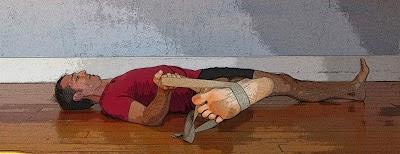Lady Gaga Bares Her Knock-Knees*
Don’t know if Nina mentioned it yesterday, but this interest in knees all started with the following question we got last week:I have a student who has knock knees (genus valgus), a condition that I gather is quite common in women. She reports that aligning her knee with her second toe in standing poses gives her knee pain. Do you or Baxter have a suggestion for her, as well as for an appropriate cue in classes that might include people with this condition?Also, many men have bow legs (genus varus); I have not yet heard complaints about problems aligning their second toe with their knee but suspect that some compensation might be necessary. If so, do you have a suggestion for them?
Whether you are a yoga teacher or a yoga student, if you don’t have knock-knees or bowlegs yourself, you have probably noticed someone in your public class (or a celebrity like Lady Gaga) who has one of these fairly common variations in leg bone relationships. And it turns out that more women are “knock-kneed” than men, and more men are “bowlegged” than women. However, I have seen cases of the reverse for both. Without going into to too much detail (but at least a little!), depending on the shape of the upper part of your thighbone, the femur bone, where the short neck of the femur (the part often broken in a “hip fracture,” especially in those with osteoporosis) meets the longer shaft of the lower part of the femur, a person might veer away from the normal angle enough to lead to one of our two conditions. When the femurs move further away from the midline of the space between your legs, referred to as “abduction” in anatomical circles, you end up with bowlegs. When the femurs move closer to the midline space between the legs, referred to as “adduction,” you end up with knock-knees.In the case of knock-knees, when the femur meets the two lower leg bones, the tibia and the fibula, the inner knee joint tends to open up towards the inside of the knee joint and the outer or lateral joint tends to compress together more than normal. Tight inner thigh muscles and weaker outer hip and leg muscles can contribute to this situation. And with the knees knocking towards one another, you can get more wear and tear on the lateral joint, and the skin of the inner knees can even sometimes rub together in an uncomfortable way on the opposite side of the joint. Julie Gudmestad put it this way in an Taking Care of the Knee for Yoga Journal on keeping the knees healthy: “…knock-knees … put increased pressure on the lateral compartment cartilage and strain the soft tissue of the medial, or inner, knee. This problem is more common in our society, and is associated, as you might expect, with arthritis in the lateral compartment.” The strain of the soft tissue of the inner knee she refers to could mean an over-stretching of ligament on that side of the joint whose job it is to keep the bones in a healthy close relationship. And the increase in the chance of arthritis is why we care about these variations in anatomy!In knock-knees, in addition to causing the inner bowing the legs of knock knees, the femur bone tends to roll or rotate inwardly, so that when you are standing in Mountain pose the knee caps end up pointing a bit toward one another instead of pointing straight ahead (or in line with second toe, as some yoga teachers recommend). Many yoga students are told to bring the inner edges of their feet very close together at the same time they are told to align the kneecaps with their second toes. In those with knock-knees, this can exacerbate the alignment even more. So, one of the first things I suggest for these practitioners is to separate the feet about hips-distance apart, sometimes with the aid of a block between the mid-thighs. I suggest they hold the block lightly between their thighs (as they may already have tight adductor muscles and we don’t want to encourage more tightness) and imagine that the block is pushing out against the inner thighs. I’d check in at this point and see if the student’s knee pain has disappeared. If it has, I’d recommend they adopt this new stance for future practice.For Mountain pose (Tadasana) and variations, Standing Forward Bend (Uttanasana) and Downward-Facing Dog pose, Donald Moyer suggests keeping the feet a bit closer together and using a block between the knees. This closer foot position will let the block push the knees apart in the bowlegged direction.Another option is to forgo the block, but keep your legs hips-distance apart, and place a looped strap around both legs, either mid-thigh or mid-calf, and press outward against the strap, feeling the strap resist that pressure. You are essentially taking the knees a bit towards the bowlegged direction, encouraging a bit of muscular strength in the outer leg muscles and a bit of stretch to the adductors of the inner thigh. You could apply this to other poses with two straight legs such as Standing Forward Bend and Seated Forward Bend (Paschimottanasana).In his book Structural Yoga Therapy, Muktananda Stiles notes that those with genus valgus (knock-knees) usually have tight adductors (inner thigh muscles), and parts of gluteus medius often are weak. The external rotators of the hip can also be weak and allow for both the knocking and the internal rotation of the thighbone I mentioned above. Muktananda Stiles also relates his personal experience with long standing knock-knees and a pivotal practice session in which he worked with Warrior 2 pose, holding it with close attention to keeping his desired knee alignment, and consciously softening and lengthening the inner thigh muscles and strengthening the outer thigh muscles of his front leg to exhaustion. He claims that as he continued to work with this over time, his knock-knees resolved! In her article, Julie Gudmestad suggests using the Reclined Leg Stretch pose version with the leg out to the side to lengthen the inner thigh muscles. This works in the standing version of this pose as well.

- Triangle pose (Trikonasana), front leg
- Extended Side Angle pose (Parsvakonasana), front leg
- Widespread Standing Forward Bend (Prasarita Padottanasana), both legs, possibly using your elbows to press your inner knees
- Wide-Angle Seated Forward Bend (Upavista Konasana)
- Cobblers Pose (Baddha Konasana)
- Half Moon pose (Ardha Chandrasana), both legs (plus, if you get the correct external rotation of the bottom thigh, you will also get some good adductor stretch)
- Tree pose (Vrksasana), top leg
- Pyramid pose (Parsvottanasana), front leg action at hip
- Warrior 1 (Virabhadrasana I), front leg action at hip


